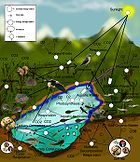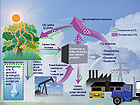- Optimal foraging theory
-
 Ants dismember a larger insect. Optimal foraging theory predicts these insects will forage in such a way as to maximize their colony's energy intake per unit time.
Ants dismember a larger insect. Optimal foraging theory predicts these insects will forage in such a way as to maximize their colony's energy intake per unit time.
Optimal foraging theory is an idea in ecology based on the study of foraging behaviour and states that organisms forage in such a way as to maximize their net energy intake per unit time. In other words, they behave in such a way as to find, capture and consume food containing the most calories while expending the least amount of time possible in doing so. The understanding of many ecological concepts such as adaptation, energy flow and competition hinges on the ability to comprehend what food items animals select, and why.
MacArthur and Pianka (1966) developed a theoretical and empirical construct, the optimal foraging theory (OFT), which led to a better understanding of foraging behavior. Emlen (1966) published a paper on foraging behavior at the same time [indeed, in the same issue of American Naturalist]. Although it was different in detail, it demonstrated the need for a model where food item selection of animals could be understood as an evolutionary construct which maximizes the net energy gained per unit feeding time. Since its original conception, there have been many papers and books published mentioning OFT which have made important contributions to a number of disciplines including ecology, psychology and anthropology. Some of these additions include papers from Earl Werner (1974), Eric Charnov (1974, 1976, 1977), Krebs (1972, 1974, 1977, 1985), Smith (1966, 1974), Ricklefs (1973), Schoener (1969, 1971, 1974, 1983), Pyke (1977, 1984), Krebs, Stephens & Sutherland (1983) and Stephens & Krebs (1986). Recently, scholars have connected optimal foraging theory to prospect theory, noting that survival thresholds might be responsible for human attitudes towards risk (McDermott et al. 2008).
The following is an outline of MacArthur and Pianka’s model.
Contents
The functional classes of predators
Optimal foraging theory uses predators as the object of analysis. There are four functional classes of predators:
- True predators attack large numbers of their prey throughout their life. They kill their prey immediately, or shortly after the attack. They may eat all or only part of their prey. True predators include tigers, lions, plankton-eating whales, seed-eating birds, ants and humans.
- Grazers attack large numbers of their prey throughout their lifetime and eat only a portion of their prey. They harm the prey, but rarely kill it. Grazers include locusts, deer, leeches and mosquitoes.
- Parasites, like grazers, eat only a part of their prey (host) but rarely the entire organism, and spend all or large portions of their life cycle living in/on a single host. This much more intimate relationship is typical of tapeworms, liver flukes and plant parasites such as the potato blight.
- Parasitoids are mainly typical of wasps (order Hymenoptera), and some flies (order Diptera). Eggs are laid inside the larvae of other arthropods which hatch and consume the host from the inside, killing it. This intimate predator-host relationship is typical of about 10% of all insects.[1] Many viruses that attack single-celled organisms (such as bacteriophage) are also parasitoids, in that they reproduce inside a single host that is inevitably killed by the association.
Basic variables of OFT
The OFT attempts to explain predator behavior since no predator eats everything available. This is typically due to habitat and size constraints, but even within habitats, predators eat only a proportion of what is available.
E is the amount of energy (calories) from a prey item. h is the handling time which includes capture, killing, eating and digesting. h starts once the prey has been spotted. E/h is therefore the profitability of the prey item.
Animals typically eat the most profitable prey types more than would be expected by chance since it will appear in the diet at a higher proportion than it is encountered in the environment. Predators do not, however, eat only the most profitable prey types. Other prey types may be easier to find, and E is not the only nutritional requirement. Toxins may be present in many prey types, therefore variability of diet prevents any one toxin from reaching dangerous levels. There are also other essential nutrients in all organism's diets, so it is clear that an approach focusing only on energy intake will not provide an adequate model.
Optimal foraging and limitations of digestive rate
The Digestive rate model (DRM) of optimal foraging makes the same basic assumption as do other models, i.e. animals select food in order to maximize their rate of energy intake. Therefore, it belongs to Optimal foraging theory. However, it makes the point that some animals should select food on the basis of its 'digestive quality' (net energy content/digestive turnover time) rather than its 'profitability' (net energy content/handling time). Food or prey can come at the expense of indigestible bulk that takes up capacity in the digestive tract. The DRM states that animals under some circumstances will maximize their digestive rate instead of their food ingestion rate or foraging behaviour as predicted by the Contingency Model, the basic and most commonly used model of OFT. The DRM is a useful alternative to the foraging models that maximize ingestion rate only, as it explains some behaviour currently looked on as deviation from OFT.
Optimal foraging and diet breadth
The predator attempts to maximize E/(h+s), where s is the search time involved. For a range of prey, the predators average intake rate is Eaverage/(haverage+saverage). Where Eaverage is the average energy of all prey items in the diet, haverage is the average handling time and saverage is the average search time.
When the predator has found an item it doesn’t currently eat, it has two choices. It can eat the new item, in which case the profitability is Enew/hnew or it can leave it and search for an item already in its diet, in which case we use Eaverage/(haverage+saverage). The predator should eat this new item when Enew/hnew ≥ Eaverage/(haverage+saverage) because the new item increases its energy intake per unit time.
This leads to new insights:
- Predators with long handling times and short search times should be generalists and include a wide range of items. For example, a bird may find any number of insects palatable, and can hunt the first insect it encounters, subdueing it rather non-efficiently.
- Specialists have a shorter handling times and longer search times; they are choosy. For example, a bird may find a limited number of insects palatable, so will spend longer periods of time searching for those specific prey items. These specialists have specific techniques in handling their selective prey, thus can minimise the handling time.
- Predators should be generalists in unproductive environments and specialists in productive environments.
- Predator-prey co-evolution often makes it non-profitable for a prey item to be included in the diet, since many anti-predator defenses increase handling time. Examples include porcupine quills, the palatability and digestibility of the poison dart frog, crypsis and other predator avoidance behaviors.
- The Digestive Rate Model suggests that species can avoid predation by increasing the amount of indigestible bulk, e.g. shell material for molluscs, seed husks or fibre content in plants.
Response curves
Since there is a search time for each item, when predator density increases the search time depends on the density of the prey. There is also a handling time which is species specific. This is best understood with a response curve:
- At low prey densities the predator is searching most of the time and eating every prey item it finds
- At high prey densities, each new prey item is caught almost immediately. The predator spends almost all of its time catching, eating or digesting the prey. It chooses only those individuals with the highest E/h.
Handling time may not be the only reason why the slope levels off:
- Confusion effects at very high prey densities occur.
- Handling time may vary between individual prey.
With a Type II functional response curve:
- At low prey densities, intake rate increases linearly with prey density, there is no handling time.
- At high prey densities, the predator has simply eaten enough.
With a Type III functional response curve:
- At high prey densities, each new prey item is caught almost immediately. The predator spends almost all of its time catching, eating or digesting the prey. It chooses only those individuals with the highest E/h.
- At low prey densities the intake rate increases faster than linearly. The predator will start to switch to this prey type as it becomes more abundant. This implies the existence of a search image.
Most predators can probably only hold a few search images at one time. Hunter-gatherers, however, may hold numerous search images, yet focus on the most profitable prey types. As the prey density increases, they become less limited by search time and more limited by handling time.
Application to biology
Predators obviously do not solve OFT equations, and most animals will deviate from the aforementioned models. Application of this model to hunter-gatherer systems has helped ecological anthropologists empirically quantify predator-prey relationships.
See also
Notes
- ^ Godfray, H.C.J. (1994) Parasitoids: Behavioral and Evolutionary Ecology. Princeton University Press, Princeton.
References
- MacArthur, R. H. and Pianka, E. R. (1966). On the optimal use of a patchy environment. American Naturalist, 100
- Kamil, Alan C., John R. Krebs and H. Ronald Pulliam. (1987). Foraging Behavior, Plenum Press, New York and London
- McDermott, Rose, James H. Fowler, and Oleg Smirnov. On the Evolutionary Origin of Prospect Theory Preferences. Journal of Politics, Vol. 70, No. 2, pp. 335-350 (April 2008)
Categories:- Behavioral ecology
- Eating behaviors
- Ecological theories
Wikimedia Foundation. 2010.


